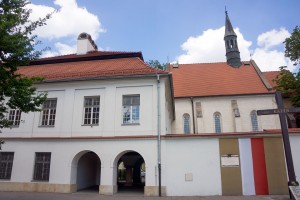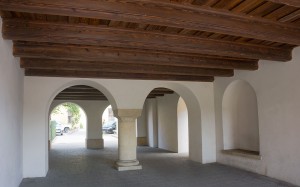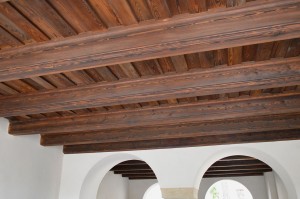Conservation
In the first two modules we explored two different situations in which new buildings were created in empty lots. In the first case a relatively distant location from the historic centre, across the river, allowed for a contrasting design. In the second case the modern building was erected right in the middle of old town hence some continuity of styles needed to be maintained. Now we come to a case of an existing building of significant historical and cultural value which, due to its deterioration over time, was in need of intervention. How should we proceed in such a case? Just maintain it? Or perhaps restructure, restore or renovate it? These are the key terms which require clarification when we come to the issue of conservation of cultural heritage.
Maintenance means all those practices that serve to prevent the aggression of external agent, like weather, microorganisms and other biological entities, on the matter of a building or any other work of historical and cultural value. Restructuring means the measures aimed at consolidating the physical structure of an object without changing in any way the shape or its artistic image, for example a replacement of a wooden roof damaged by termites. By the term restoration we mean instead the kind of operation that also regards the artistic aspect of a work, for example through the integration of missing or unrecoverable parts with new elements. The term renovation is more common when we refer to ordinary objects such as doors, windows, furniture etc. that need to be refreshed. Renovation simply means to make an object look like new. But in this case the object is just a base or starting point for the designer’s imagination. The object, materials and method of construction, historical importance, or place in time are not critical. The object itself does not place restrictions on the work to be done.
To be more clear, let’s stress the difference between renovation and restoration as it may cause some confusion. Restoring means to return a space or an object to its original appearance. It would mean refinishing the floor, the woodwork, the materials, the accessories, but not changing their original colors. If it is renovation instead it would be fine to use another color on the woodwork and the floor with the understanding that you’ll be changing the design that was originally intended by the architect. Therefore, the word renovation means to “make something existing new.” The word restoration has instead the meaning “to restore to previous condition.” No upgrades, modernization, or change of use occurs under the umbrella of restoration.
Having all the above in mind let’s have a closer look at the building in focus. It is one of the oldest brick churches in Kraków. Its facade has been recently restored as well as its roof. New materials, plaster and tiles, have been used but with an intention to bring the building back to its original shape and splendor. No changes or additions have been allowed to modernize it or depart in any way from what is believed to be its authentic character. Accordingly, this is a clear case of restoration. Magnify the facade to see it better.
The church has its interior also restored. The conservation approach is consistent with the work done on the outside. The pictures show an entrance to the cloisters. The medieval ceiling has been cleaned and varnished and the walls plastered. They are left blank as any additions would interfere with their authenticity. The restoration is limited here to interventions on the material of the ceiling, walls and columns without affecting in any way the aspect in which they have survived. With the concept of authenticity we come to an important point in the modern discussions of the principles of restoration. We need to investigate this issue in some detail.
Nowadays the main purpose of restoration is to allow the conservation of what is authentic in an object which has a historical and cultural value. It is a priority to safeguard a work that can be considered a historical document, both in its origin and subsequent history. This is substantially different from an intention of restoring its initial state that, in most cases, may be completely unknown. This principle means that you must not work on the image of an object to make it even more attractive than the original or to adapt it to contemporary taste.
Another aspect considered essential in the practice of restoration is the recognition of the intervention. Essentially any intervention operated on an object must be recognizable, even if not immediately visible, so as to be able to distinguish in each case what is authentic from what we have inserted to ensure its survival and future preservation. Magnify the ceiling view in the picture to see the original fractures of the wood. If any reconstructions are made they have to be clearly distinguishable from the authentic parts.
Interventions must be made always with materials of proven compatibility with the originals and integrated in the object with a prior planning so that the authentic and inauthentic parts remain always separated. Any intervention must be preceded by a careful analysis of the historic object on which you are going to operate. It is essential, before any restoration work, to know everything you can know about the object in focus, both about its genesis and subsequent history up to the present, especially about all the transformations and restorations occurred previously. Every action must be accompanied by a careful analysis of the materials and factors that have affected their durability. Before proceeding to an intervention you must make a diagnosis like a doctor, with a clear history of symptoms and probable diseases that produced them. The findings should then be clearly indicated and documented.
To close this module we’d like to encourage you to identify, analyse and document at least one case of a historic building in your area in need of restoration. You’ll find some examples of such documentation done by students of revalorisation of cultural heritage at one of Kraków academies. They created their own website for all those interested in this field. One of the resources shared on this portal is a template useful for such analysis.



